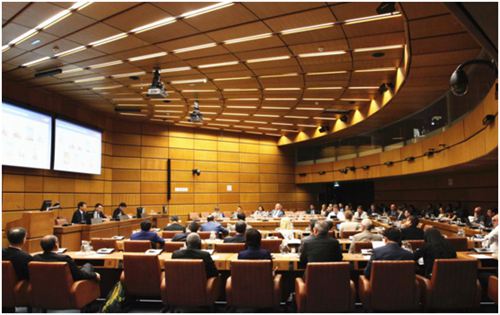On September 18th, the theme promotion conference of “the World’s First AP1000 Unit Project Progress and Major Special Achievements” hosted by China Atomic Energy Authority (CAEA) and organized by Shanghai Nuclear Engineering Research and Design Institute of SPIC was successfully held at the IAEA headquarters in Vienna, Austria. The theme promotion conference comprehensively introduced China's nuclear power passive technology and the progress of Gen III nuclear power autonomation. Ambassador Wang Qun, Permanent Representative of the People’s Republic of China to the United Nations in Vienna and other international organizations, delivered a speech at the theme promotion conference. Zheng Mingguang, Deputy General Manager of SNPTC, made a keynote speech on behalf of SPIC.

Ambassador Wang Qun said that Innovation-driven Green Energy Development had been China's long-standing strategic orientation for energy development. So far, more than a decade has passed since China's embracing and implementing the world’s advanced nuclear power technology with an open mind, and China’s nuclear power development has achieved remarkable results. China has a strong industrial capacity and manufacturing capacity, as well as a complete industrial chain system and nuclear industry system to support global nuclear power development.
Zheng Mingguang expressed that the implementation of major state specialized projects has comprehensively enhanced the collaborative innovation capacity of China’s Gen III nuclear power technology. Gen III nuclear power technology has undergone the engineering verification for over 10 years, thus its safety, economy and reliability has been verified
When exclusively interviewed by the journalist of European Times, Zheng Mingguang expressed that the operation of the first AP1000 unit in China fully demonstrated China's capacity in mature nuclear power design, construction and operation. The construction conditions for CAP1400 with the proprietary intellectual property rights have been fully met, and China's proprietary nuclear power technology is enough for the implementation of “Beautiful China” strategy and will serve for the world nuclear power development safely and efficiently.
Experts from Canada, US, South Korea and other countries highly evaluated the development of China’s nuclear power industry and assured that the first AP1000 unit operation shall instill confidence and strength into global nuclear power. Representatives of all parties conducted in-depth and lively exchanges on such questions as test verification, economy, serialization of nuclear power products and nuclear energy development plan.
The implementation of CAP1400, a pressurized water reactor power plant of key state science and technology specialized project, broke through a series of key equipment design and manufacturing technologies, and formed the supporting capacity and supply chain of Gen III nuclear power equipment, thus driving the leap-forward development of China's equipment manufacturing industry. So far, 99% of CAP1400 demonstration project design has been completed and the localization rate of the equipment has reached above 90%. In April 2016, it passed IAEA Generic Reactor Safety Review, thus further recognized by the international authority, laying a solid foundation for its “going global” and its participation in higher-level international competitions.
SPIC is one of China's three largest nuclear power investment operators and a leading nuclear power technology supplier. Following the requirements of the State Council, SPIC takes its held industrial group (SNPTC) as the platform to undertake the strategic task of Gen III introduction, assimilation and re-innovation. From the R&D and design of China’s first NPP (Qinshan NPP) and China’s first export NPP (Pakistan Chashma NPP) to the R&D of world leading CAP1400 Gen III passive pressurized water reactor NPP, SPIC has become an important competitive force for global nuclear power industry.